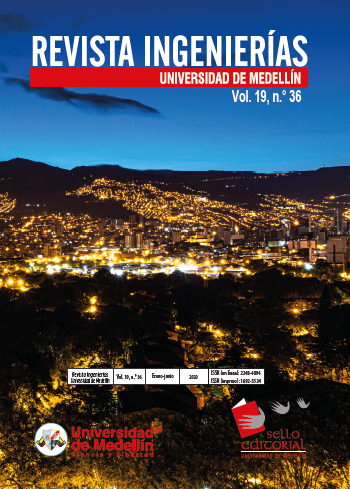Modelado y control no lineal de ácidos grasos volátiles en un biorreactor anaerobio de lecho fijo y flujo ascendente (UAFBR)
Derechos de autor 2023 Revista Ingenierías Universidad de Medellín

Esta obra está bajo licencia internacional Creative Commons Reconocimiento-NoComercial-SinObrasDerivadas 4.0.
- Articles
- Enviado: octubre 18, 2018
-
Publicado: julio 9, 2019
Resumen
En este trabajo se presenta una estrategia de regulación robusta de los ácidos grasos volátiles (AGVs) en un proceso de digestión anaerobia. La estrategia propuesta es una ley de control por retroalimentación no lineal obtenida por linealización entrada-salida que permite alcanzar el objetivo de control a pesar de errores de modelado (incertidumbres en la cinética de las reacciones) y las restricciones del actuador. Los experimentos fueron conducidos con un reactor anaerobio piloto de lecho fijo y flujo ascendente (UAFBR) con volumen activo de 0.947 m3, completamente equipado, utilizado para el tratamiento de aguas residuales provenientes de una destilería de vino en Narbonne-Francia. Con el objetivo de validar los modelos utilizados, resultados simulados y experimentales son presentados y discutidos. Los parámetros de desempeño del controlador bajo los modelos AM2 y ADM1 (tiempo de subida, tiempo de establecimiento, sobre impulso y error en estado estacionario) obtenidos de las simulaciones numéricas, prueban la eficiencia y la aplicabilidad de la estrategia de control propuesta.
Referencias
- [1] A. Mottet, I. Ramírez, H. Carrère, S. Déléris, F. Vedrenne, J. Jimenez, y J.P. Steyer, “New fractionation for a better bioaccessibility description of particulate organic matter in a modified ADM1 model”, Chemical Engineering Journal, [En línea], vol. 228, pp. 871-881, 2013. DOI: 10.1016/j.cej.2013.05.082
- [2] I. Ramírez, “Anaerobic digestion modelling: from one to several bacterial populations”, Revista TecnoLógicas , [En línea], vol. 31, pp. 181-201, 2013.
- [3] M. Henze, P. Harremos, J. LA Cour Jansen, y E. Arvin, Wastewater Treatment: Biological and Chemical Process, 3.a ed. Springer Science and Business Media, 2001.
- [4] D.M. Revelo, N.H. Hurtado, y J.O. Ruiz, “Microbial Fuel Cells (MFCS): a challenge for the removal of organic matter and electricity generation”, Información tecnológica, [En línea], vol. 24, n.° 6, 2013. DOI:10.4067/S0718-07642013000600004
- [5] J.P. Steyer, O. Bernard, D.J. Batstone, y I. Angelidaki. “Lessons learnt from 15 years of ICA in anaerobic digesters”, Water Science and Technology, [En línea], vol. 53, n.° 4, pp. 25-33, 2006. DOI: 10.2166/wst.2006.107
- [6] D.J. Batstone, J. Keller, I. Angelidaki, S. Kalyuzhnyi, S.G. Pavlostathis, A. Rozzi, y V.A. Vavilin. “The IWA anaerobic digestion model no 1 (ADM1)”, Water Science and Technology, [En línea], vol. 45, n.° 10, pp. 65-73, 2002. DOI: 10.2166/wst.2002.0292
- [7] O. Bernard, Z. Hadj-Sadok, D. Dochain, A. Genovesi, y J.P. Steyer, “Dynamical model development and parameter identification for an anaerobic wastewater treatment process”, Biotechnology and Bioengineering, [En línea], vol. 75, n.° 4, pp. 424-438, 2001. DOI: 10.1002/bit.10036
- [8] S. García-Gen, J.M. Lema, y J. Rodríguez. “ADM1 application to anaerobic co-digestion: generalised implementation of fermentable soluble substrates”, Presentado en the 13th world congress on Anaerobic Digestion. Santiago de Compostela, Spain, 2013. DOI: 10.1016/j.biortech.2013.08.063
- [9] H.O. Méndez-Acosta, B. Palacios-Ruiz, J.P. Steyer, V. Alcaraz-Gonzáles, E. Latrille, y V. Gonzáles-Alvarez. “Nonlinear approach for the VFA regulation in an anaerobic digester”, en 10th International IFAC Symposium on Computer Applications in Biotechnology, 2007. DOI: 10.3182/20070604-3-MX-2914.00015
- [10] D. Selisteanu, E. Petre, y V.B. Rasvan, “Sliding mode and adaptative sliding-mod control of a class of nonlinear bioprocesses”, International Journal of Adaptive Control and Signal Processing, [En línea], vol. 21, pp. 795-822, 2007. DOI: 10.1002/acs.973
- [11] C. Kravaris, y G. Savoglidis, “Tracking the singular arc of a continuous bioreactor using sliding mode control.” Journal of the Franklin Institute, vol. 349, n° 4, pp. 1583-1601, 2012. DOI: 10.1016/j.jfranklin.2011.06.011
- [12] M.R.S. Khan, y R.N.K. Loh, “Nonlinear Control of Bioprocess Using Feedback Linea-rization, Backstepping, and Luenberger Observers”, International Journal of Modern Nonlinear Theory and Application, [En línea], vol. 3, n.° 4, pp. 150-162, 2014. DOI: 10.4236/ijmnta.2014.34017
- [13] I. Ramirez, “Integrating Biotechnology and Microbial Ecology in Bioprocesses Control”, International Journal of Emerging Technology and Advanced Engineering, vol. 8, n.° 5, 2018.
- [14] I. Ramirez, “Experimental and modeling investigations of an up-flow anaerobic fixed bed reactor (UAFBR)”, Environmental Biotechnology Laboratory, INRA, Narbonne-France, Tech. Rep. LBE-006-69-3, [En línea], p. 160, Abr. 2010. DOI: 10.2166/wst.2008.342
- [15] I. Ramirez, y J.P. Steyer, “Modeling microbial diversity in anaerobic digestion”, Water Science and Technology, [En línea], vol. 57, n.° 2, pp. 265-270, 2008. DOI: 10.2166/wst.2008.055



















